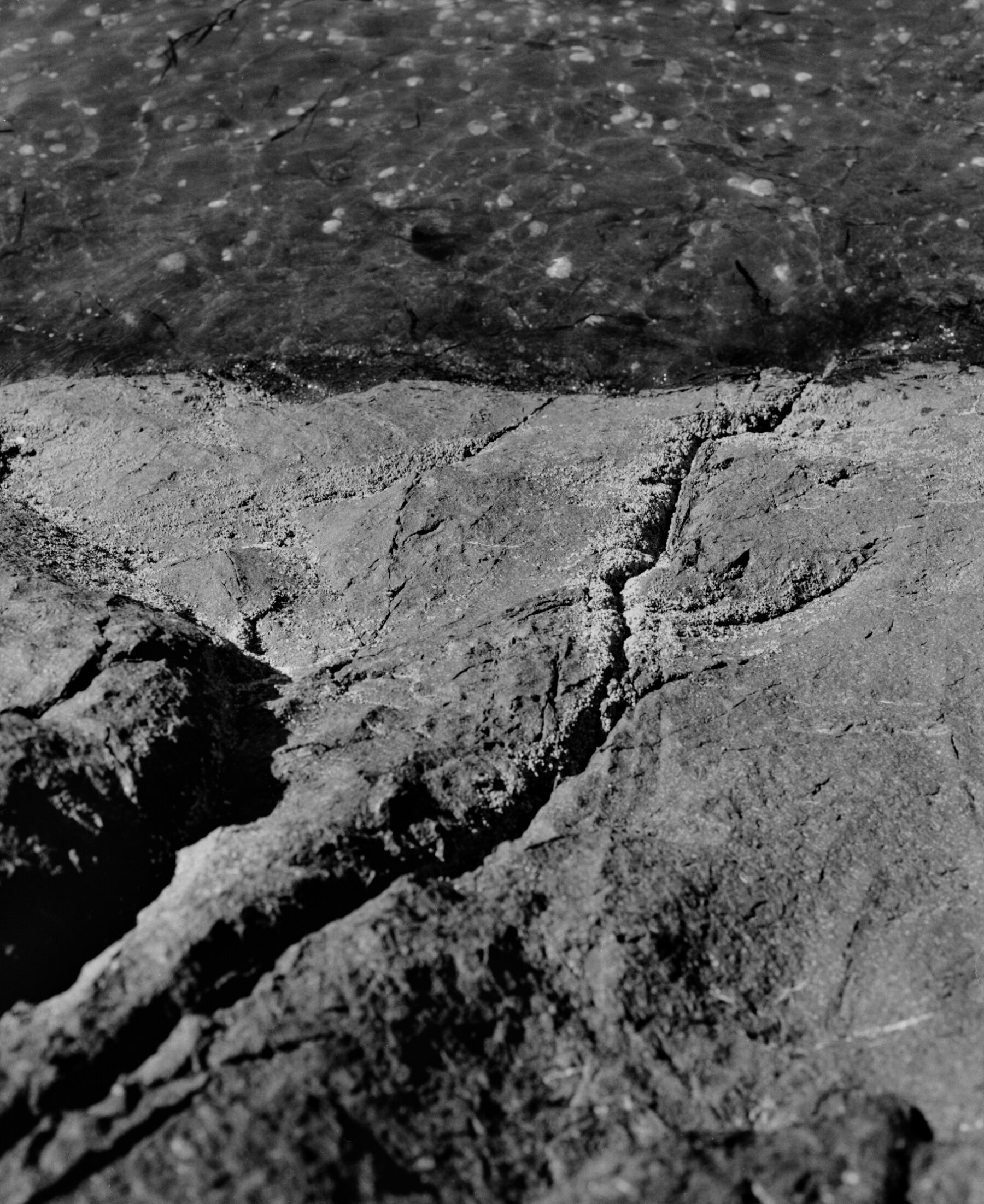
I return to hutchinson cove to film the sea, but the tide is out and the wind is strong. I wander the shore which juts in its familiar ways, clamber the sloping rocks to a log that stretches across their peaks, joining them over a small gully. They have always been there, to my memory. This is the first place I encountered the sea, as a small child. So much has changed now, but the nuances of this shoreline I know deep inside my body. The tide is as far out as it can be, and we walk across the wet sand and mud to the cliffs we used to swim to. My parents huddle out of the wind near the mouth of Veitch Creek, a salmon bearing steam that runs into the cove. I thread my footsteps along the water's edge, tracing something I can’t quite name. Nothing here is how it’s supposed to be. They are building a highway through the bottom of our old place, fifty feet from the home my parents built alongside my grandfather—a carpenter whose sturdy hands constructed the walls and floors, as well as my fifth-grade bridge making project. The home with the room my granny died in when I was two and a half, where she came from Scotland with six weeks to live; where my parents were married, where I was christened with a verse from the Carmina Gadelica, and named with a blessing written by my godfather, the witch. A home of ceremony. The graveyard we populated, with two dogs, two cats and a doe we found under the porch, has a highway survey line through it. A dozen or so feet along the banks of the gully is where my parents came back one night to bury the cat Zipper. She too will become part of the highway. But what remains to mark our lives? It begins to rain and my parents return to the car to wait. I wander back and forth, film things that don’t feel important, long for the sea to come coursing in to me. Around the rocks, where a newer path head begins, lies an old rusted out marine buoy. Enormous and now part of the landscape, it has been there as long as my memory allows, or close to it. I used to stand on top of it but its fragile body will no longer hold my weight. Instead I film its stillness like a long, unending photograph. I wait for something to emerge or transform. The wind shuffles the grasses behind it and I film them too. My body remembers the shapes of this place, but my memory of what used to be has distanced me from it. Perhaps as a means of preserving. Leaving this place was the loss of an inner language, orientation and an emptying I can never refill. The sounds and smells are specific to here, the ghosts of those I have loved, still here.



I return to hutchinson cove to film the sea, but the tide is out and the wind is strong. I wander the shore which juts in its familiar ways, clamber the sloping rocks to a log that stretches across their peaks, joining them over a small gully. They have always been there, to my memory. This is the first place I encountered the sea, as a small child. So much has changed now, but the nuances of this shoreline I know deep inside my body. The tide is as far out as it can be, and we walk across the wet sand and mud to the cliffs we used to swim to. My parents huddle out of the wind near the mouth of Veitch Creek, a salmon bearing steam that runs into the cove. I thread my footsteps along the water's edge, tracing something I can’t quite name. Nothing here is how it’s supposed to be. They are building a highway through the bottom of our old place, fifty feet from the home my parents built alongside my grandfather—a carpenter whose sturdy hands constructed the walls and floors, as well as my fifth-grade bridge making project. The home with the room my granny died in when I was two and a half, where she came from Scotland with six weeks to live; where my parents were married, where I was christened with a verse from the Carmina Gadelica, and named with a blessing written by my godfather, the witch. A home of ceremony. The graveyard we populated, with two dogs, two cats and a doe we found under the porch, has a highway survey line through it. A dozen or so feet along the banks of the gully is where my parents came back one night to bury the cat Zipper. She too will become part of the highway. But what remains to mark our lives? It begins to rain and my parents return to the car to wait. I wander back and forth, film things that don’t feel important, long for the sea to come coursing in to me. Around the rocks, where a newer path head begins, lies an old rusted out marine buoy. Enormous and now part of the landscape, it has been there as long as my memory allows, or close to it. I used to stand on top of it but its fragile body will no longer hold my weight. Instead I film its stillness like a long, unending photograph. I wait for something to emerge or transform. The wind shuffles the grasses behind it and I film them too. My body remembers the shapes of this place, but my memory of what used to be has distanced me from it. Perhaps as a means of preserving. Leaving this place was the loss of an inner language, orientation and an emptying I can never refill. The sounds and smells are specific to here, the ghosts of those I have loved, still here.
